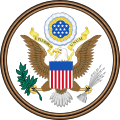| Great Seal of the State of Michigan | |
|---|---|
 | |
| Armiger | State of Michigan |
| Adopted | July 22, 1835 (standardized 1911) |
| Motto |
|
The Great Seal of the State of Michigan depicts the coat of arms of the U.S. state of Michigan on a light blue field. On the dark blue shield the Sun rises over a lake and peninsula, a man holding a long gun with a raised hand represents peace and the ability to defend his rights. The elk and moose are symbols of Michigan, while the bald eagle represents the United States.
Contents
The design features three Latin mottos. From top to bottom they are:
- On the red ribbon: E Pluribus Unum , "Out of many, one", a motto of the United States
- On the blue shield: Tuebor, "I will defend" [1]
- On the white ribbon: Si Quæris Peninsulam Amœnam Circumspice, "If you seek a pleasant peninsula, look about you", which is the official state motto. It was adopted in 1835 and is said to have been suggested by the tribute to architect Christopher Wren at Saint Paul's Cathedral in London, which reads Si monumentum requiris, circumspice (Latin "If you seek [his] monument, look around you").
This seal was adopted in the year of 1835, on June 22. [2]
Public Act 19 of 1963 states that "The great seal shall be comprised of the coat of arms of the state around which shall appear the words 'great seal of the state of Michigan, A.D. MDCCCXXXV'." [3]







